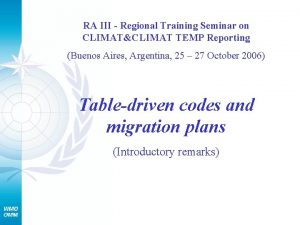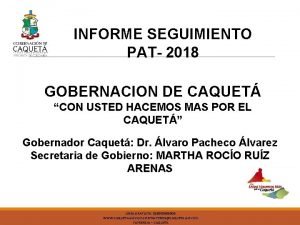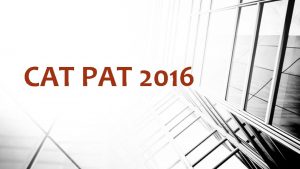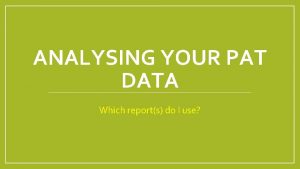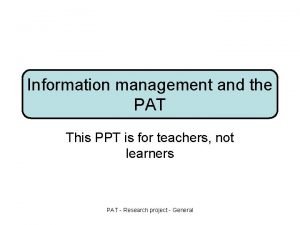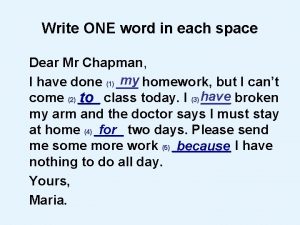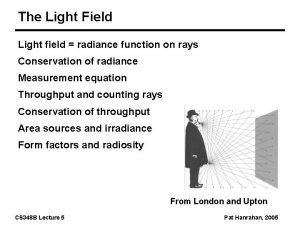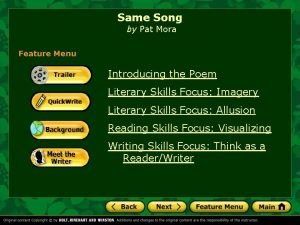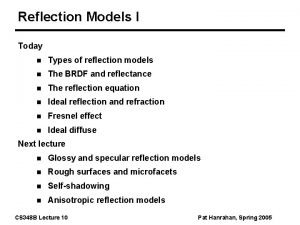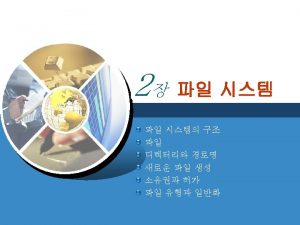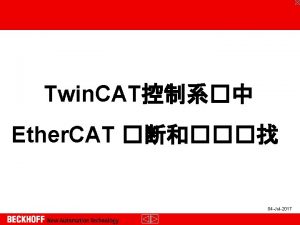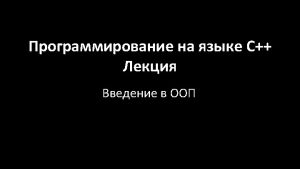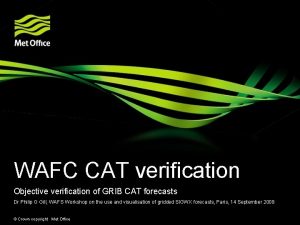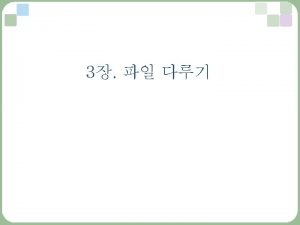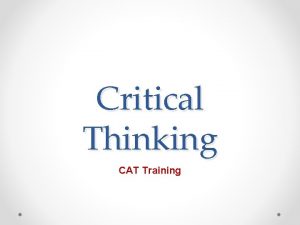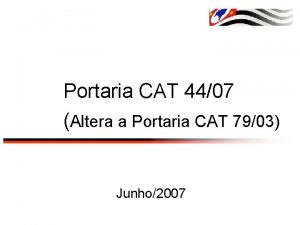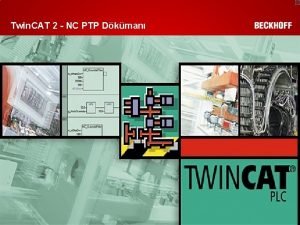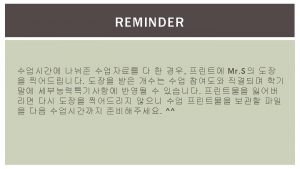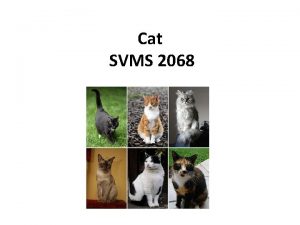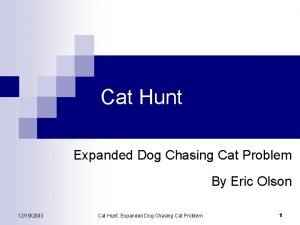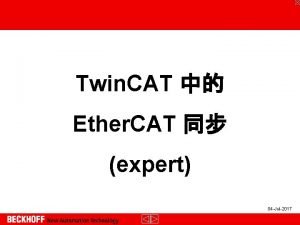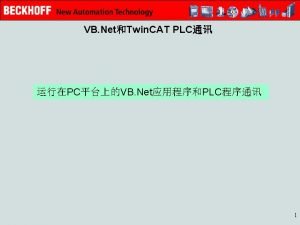CAT PAT 2016 WHAT IS THE PAT Research

























































- Slides: 57

CAT PAT 2016

WHAT IS THE PAT? • Research project • Implemented during three terms of the year • Broken into 3 phases

WHAT IS THE PAT? Problem Research Solution

WHY IS THE PAT MARK IMPORTANT? SBA 25 PAT 25 100% P 1 25 P 2 25

WHY IS THE PAT MARK IMPORTANT? SBA PAT P 1 P 2 10 20 10 10 50% 20 20 62% 7 2 15 15 39% Absence of a PAT mark for CAT, without a valid reason, will mean that you will not receive a result for CAT. Penalisation if not submitted on time!

TEACHER GUIDELINES Before starting the PAT learners need to be taught the following: • Application software (word processing, spreadsheet, database and web development software) • ICT skills that will enhance the creation of the report and website • Research and information management skills (define a task, set a focus, identify and ask questions, search for and identify suitable sources of information, evaluation of sources, etc. ) • Accepted forms of research reports with abstract, introduction, discussion with sources cited, conclusion, references list. • Project management skills (time, resource and task management)

DISHONESTY Addendum C Learners must NOT: • Get help/guidance from others without acknowledgment thereof • Submit work which is not their own • Lend their work to other learners • Allow other learners access to, or the use of, their own independently-sourced source material • Include work copied directly without acknowledging the source • Submit work typed or word-processed by a third person

ROLE OF THE TEACHER • Manage the project, supervise, monitor • Initial planning session to discuss • Facilitate pre-reading to gain background information about the topic • Give regular feedback to learners • Assess the work of the learners at the end of each phase and record feedback given • General evaluation based on continuous observation • Ensure the authenticity of the PAT

SUPERVISED/CONTROLLED CONDITIONS • Monitoring the learner's work on a continuous basis • Endorsing each learner's assessment at the end of each phase • Confirming that the work assessed is solely that of the learner concerned.

ASSESSMENT EVIDENCE • Evidence presented for assessment: a website (home page plus 2 other pages) o a written report o learner assessment tool o • Include the planning, feedback and progress of the project.

NON-COMPLIANCE • Learners will be given three weeks before the commencement of the final end-of-year examination to submit outstanding work or present themselves to complete the PAT. • If a learner submits no PAT, without a valid reason p 7, the learner will not receive a result in the subject.

MARK DISTRIBUTION OF PHASES General 20 11% Phase 3 84 47% Phase 1 32 18% Phase 1 Phase 2 44 24% Mark 2016 2015 Focus Find access data and information 32 36 Phase 2 Process data and information 44 46 Phase 3 Present information/solution 84 73 20 25 Observations made and overall General evaluation TOTAL 180

GENERAL EVALUATION • Attitude, commitment and work ethic • Effort • Independent working skills • Organisational skills • Producing professional work

TOPIC Topic 1 • Electricity tariffs set to soar • Consumers urged to reduce power consumption to avoid national blackout • South Africans need to learn to be energy efficient at home • High costs of living off the electricity grid • Reduce electricity usage – going green but at what cost? • Not enough South Africans conserving electricity

OR Topic 2 • Another province declared a disaster area due to the drought • Water shedding instituted across entire province • Save water for a sustainable future says Minister • Price of food may double due to the drought • Just 30 days of water left! • Practical hints for water saving

ELECTRICITY OR WATER Problems in South Africa

AND HOW IT AFFECTS … • THE ECONOMY • HEALTH SERVICES • COMMUNITY LIFE • DAILY LIVING AND LIFESTYLES

Your task … • Investigate the current situation in South Africa • Gather and analyse data relevant to the investigation • Identify possible problems and solutions to the problems • Present your research and findings in a report suitable for use by institutions Problem Research Solution

• Create a suitable folder structure • Formulate a task definition and a focus PHASE 1 question • Draw up questions to guide the process/ research • Identify sources to find quality information • Identify the research methods you will use • Perform background research • Critically assess information sources • Start the final report

• Draw up and conduct a PHASE 2 questionnaire/survey • Design and use a spreadsheet and database to analyse the survey results and other data/statistics gathered • Continue refining the final report as needed

• Draw up findings, conclusions and PHASE 3 recommendations in your own words • Compile a word processing report and a website to report on the process, findings and recommendations

PHASE 1 Task definition Focus question Research questions PHASE 2 Identify Sources Evaluate Sources Questionnaire Process data PHASE 3 Create Report Referencing Present INFORMATION MANAGEMENT

PHASE 1 – Create a suitable folder structure

PHASE 1 – Create a report Addendum B • Cover page • Headings – Introduction Task definition Focus Question Findings Conclusion Appendices • Addendum of screenshot with folder structure

PHASE 1 – Task definition • ± 300 words or half a page in font size 12 pt o Why am I doing the investigation? o What is the current situation and the purpose of the investigation (desired outcome? ) o What will the focus of my investigation be? o Considering all the PAT requirements, how will I go about the investigation? o Who is the target audience

PHASE 1 – Focus question A single sentence • Clearly phrase, concise, researchable • Describe exactly the focus of the investigation • Relevant to focus point of the topic •

PHASE 1 – Ask questions that will guide your investigation Create addendum • 10 questions • From 3 out of the 4 levels • Level Type of level or quality of question Provide facts (who, when, where, what, how many, etc. ) Give direction to the investigation (why, how, etc. ) Support predictions or help with any changes, alternatives or variations (what if, etc. ) Support your judgement or help to evaluate, critique, review or find meaning (would it be better if, what recommendation, what would be best, etc. ) • Group under 3 categories (topics/subtopics)

PHASE 1 – Identify sources Locate sources for each question o Internet (at least 2 websites) o One other sources e. g. magazine, newspaper etc. o Excluding questionnaire • Bibliographical information of the sources • Minimum 3 sources • ADD AS BIBLIOGRAPHY IN REPORT •

PHASE 1 – Identify sources Website sources x 2 Author(s)/Organisation/Publisher Spark, James Name of Website and Web Page Conserving Power - Power Struggles Date created/updated 12 January 2016 Date accessed 14 February 2016 URL www. example. com Name of Web Page Conserving Power

PHASE 1 – Identify sources Other source x 1 Author(s) Cabala, Xolani Title of book/magazine Solar power for all Date published/issued December 2015 Publisher Power Press City 14 February 2016

PHASE 1 – Evaluate quality of information Criteria Motivation/Explanation Authority The ‘validity’ or ‘credentials’ of the publisher or author(s) Currency The date on which the material was published or updated Accuracy The correspondence of the information with other sources Objectivity Any presence of prejudice, bias, skewing of information, etc. Coverage How extensively the material covers the topic

PHASE 1 – Evaluate quality (EXAMPLE) Criteria Motivation/Explanation Authority The author is a leading DIY specialist in SA and is published in several leading magazines as well. Currency The article was originally published in 2015 but was updated to reflect the latest developments in January of this year. Accuracy Information provided corresponds with other sources and is also accurate in terms of providing recent prices. Objectivity There is no bias on the web page and the information is presented in a factual, objective fashion Coverage The article provides extensive coverage on a wide variety of power saving measures.

PHASE 1 – Engage and use information • Save a copy (screenshot/copied content) of each website (Print. Friendly. com) • Extract appropriate information

PHASE 1 – Engage and use information • Record/Save the information (in learners own words) in ONE of the following two ways: Summary of information found Look at ‘hungry appliances like geysers (reduce temperature). Try to generally use less hot water – use showers instead of bathing, take shorter showers, only fill the kettle as much as you need it. Rather wash a full load of dishes, rather than one dish at a time. Switch off equipment not in use at the wall plug, rather than leaving them on standby. OR Summary of Information found Hyperlink to summary 1

PHASE 1 Analysis grid

COPY THE REPORT FROM THE PHASE 1 TO THE PHASE 2 FOLDER

PHASE 2 – Create and conduct a questionnaire • Create a questionnaire in a word processor – save the original • Administer the questionnaire for at least 25 respondents (e-mail, link, manual, printed, online, etc. ) • At least 5 questions, excluding biographical data • Store the completed questionnaires

PHASE 2 – Questionnaire • Use content controls/form fields • Appropriate headings • Clear instructions for users • At least 5 questions • Related questions should be grouped together under relevant headings • Maximum of one page • Professional formatting and layout

PHASE 2 – Process and analyse data in spreadsheet Data from questionnaire • Other data from sources •

PHASE 2 – Spreadsheet • Technical o o • Separate worksheets Layout Formatting Easy to read (interpret) Quality o o Relevant data Appropriate processing Analysis other than questionnaire No processing errors

PHASE 2 – Spreadsheet (Graphs) 2 graphs • Appropriate types of graphs • Easy to interpret •

PHASE 2 – Spreadsheet (Complexity) Level Examples of formulas/functions Simple functions that only use/include a single cell range, e. g. Sum, Max, Min, Count, Average, Mode, Median, Len, Value or a formula using any of the arithmetic operators ( +, – , *, / ) Functions that include a cell range and one other parameter/condition, e. g. Round, Large, Small, Left, Right, Concatenate, Countif, Sumif OR Calculations using a combination of arithmetic operators and brackets, or calculations using a combination of any two simple functions at level Functions that include a cell range plus two parameters/conditions, e. g. Power, Mid, Find, Countifs, Roundup, Randbetween or a simple IF-function or any of the Date and Time functions OR Any combination of more than two functions of arithmetic operators, brackets and other functions A Lookup or nested IF-function or functions not in the CAT CAPS curriculum

PHASE 2 – Process and analyse data in database At least one table (25 records) • Appropriate, meaningful fields names • Appropriate data types and formatting • Fields contain single data units (for example separate fields for Name and Surname) • 2 Queries • 1 Report •

PHASE 2 – Database (Validation) Appropriate field sizes • One validation rule and validation text • One list/combo box • One input mask •

PHASE 2 – Database (Queries Complexity) Level Complexity of query Only fields with 1 simple criterion (e. g. 'X', >X, =X, not 'X', Is Null) One field with combined criteria using conditions and relational operators (e. g. 'X' or 'Y', >1 and < 10 or ranges such as ‘Between 1 and 10’) OR One field with criterion including wild cards (‘*’ or ‘? ’) Simple calculated field using arithmetic operators ( +, – , *, / ) OR Date and time functions/calculations Complex calculated field (e. g. Sum, Min, Max, Avg, Count) OR Queries that use Grouping OR Queries that use logical (IIF) or text functions OR Advanced functions that are not in the CAT CAPS curriculum

PHASE 2 – Database (Report) Sorted according to 1 field • 1 Meaningful calculation • Grouped on 1 field • 1 Group calculation •

PHASE 2 – Continue with the FINAL Report Copy the report from Phase 1 to the relevant Phase 2 folder • Add graphs under the Findings heading •

PHASE 2 Analysis grid

COPY THE REPORT FROM THE PHASE 2 TO THE PHASE 3 FOLDER

PHASE 3 – Report • 6– 10 pages o o o A cover page An introduction The report body The findings and conclusions Any appendices that are needed

PHASE 3 – Report (Cover page) Name and surname • Name of school • Topic • Abstract (3 – 4 lines) •

PHASE 3 – Report (Content) Final report Table of contents Remember Addendum B • Table of figures • Introduction (rephrase task definition and focus question) • Body (add headings, summaries, questionnaire, spreadsheet and database information from Phase 2) • Hyperlinks Report Checklist • Conclusion •

PHASE 3 – Website • Home page + 2 other web pages o Title o Introduction o Navigation system o Quality information o Hyperlinks Website Checklist

PHASE 3 Analysis grid

GENERAL • • • Attitude, commitment and work ethic Effort Independent working skills Organisational skills Producing professional work Analysis grid

MODERATION Phase 1 – June 2016 • Phase 2 – September 2016 • Phase 3 – October 2016 •

THE END How to save water
 Cat 1 cat 2 cat 3 aviation
Cat 1 cat 2 cat 3 aviation Ils cat 1 minima
Ils cat 1 minima Pat pat seguimiento
Pat pat seguimiento Cat pat example
Cat pat example Pat data analysis
Pat data analysis Pat 1
Pat 1 Pat
Pat Information management ppt
Information management ppt I bought me a cat
I bought me a cat Hát kết hợp bộ gõ cơ thể
Hát kết hợp bộ gõ cơ thể Frameset trong html5
Frameset trong html5 Bổ thể
Bổ thể Tỉ lệ cơ thể trẻ em
Tỉ lệ cơ thể trẻ em Voi kéo gỗ như thế nào
Voi kéo gỗ như thế nào Tư thế worms-breton
Tư thế worms-breton Chúa yêu trần thế
Chúa yêu trần thế Kể tên các môn thể thao
Kể tên các môn thể thao Thế nào là hệ số cao nhất
Thế nào là hệ số cao nhất Các châu lục và đại dương trên thế giới
Các châu lục và đại dương trên thế giới Công thức tiính động năng
Công thức tiính động năng Trời xanh đây là của chúng ta thể thơ
Trời xanh đây là của chúng ta thể thơ Mật thư tọa độ 5x5
Mật thư tọa độ 5x5 Làm thế nào để 102-1=99
Làm thế nào để 102-1=99 độ dài liên kết
độ dài liên kết Các châu lục và đại dương trên thế giới
Các châu lục và đại dương trên thế giới Thể thơ truyền thống
Thể thơ truyền thống Quá trình desamine hóa có thể tạo ra
Quá trình desamine hóa có thể tạo ra Một số thể thơ truyền thống
Một số thể thơ truyền thống Cái miệng bé xinh thế chỉ nói điều hay thôi
Cái miệng bé xinh thế chỉ nói điều hay thôi Vẽ hình chiếu vuông góc của vật thể sau
Vẽ hình chiếu vuông góc của vật thể sau Thế nào là sự mỏi cơ
Thế nào là sự mỏi cơ đặc điểm cơ thể của người tối cổ
đặc điểm cơ thể của người tối cổ Ví dụ giọng cùng tên
Ví dụ giọng cùng tên Vẽ hình chiếu đứng bằng cạnh của vật thể
Vẽ hình chiếu đứng bằng cạnh của vật thể Fecboak
Fecboak Thẻ vin
Thẻ vin đại từ thay thế
đại từ thay thế điện thế nghỉ
điện thế nghỉ Tư thế ngồi viết
Tư thế ngồi viết Diễn thế sinh thái là
Diễn thế sinh thái là Dot
Dot Số nguyên tố là số gì
Số nguyên tố là số gì Tư thế ngồi viết
Tư thế ngồi viết Lời thề hippocrates
Lời thề hippocrates Thiếu nhi thế giới liên hoan
Thiếu nhi thế giới liên hoan ưu thế lai là gì
ưu thế lai là gì Hươu thường đẻ mỗi lứa mấy con
Hươu thường đẻ mỗi lứa mấy con Sự nuôi và dạy con của hươu
Sự nuôi và dạy con của hươu Sơ đồ cơ thể người
Sơ đồ cơ thể người Từ ngữ thể hiện lòng nhân hậu
Từ ngữ thể hiện lòng nhân hậu Thế nào là mạng điện lắp đặt kiểu nổi
Thế nào là mạng điện lắp đặt kiểu nổi Write one word for each space
Write one word for each space Pat oliphant cartoon archive
Pat oliphant cartoon archive Phonetics
Phonetics Pat coso
Pat coso Princess pat lyrics
Princess pat lyrics Same song by pat mora
Same song by pat mora Pat coso
Pat coso
